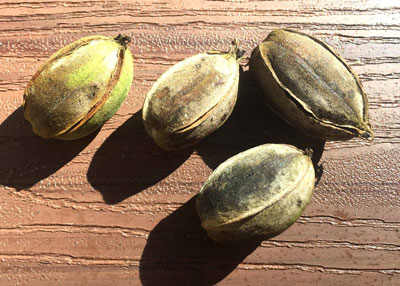Question of the Week 2: September 14, 2017
“Neil, I have pecans all over the ground. Isn’t this unusually early for them to be falling?”
This is the result of a fungal disease called pecan scab. It attacks pecans much earlier in the growing season, especially when we’ve had a cool, wet spring (like we did this year).

Photo: Pecans + black hulls + on the ground in September = pecan scab.
The pecans start hitting the roof and driveway by August and September, and your first observation is that the husks have large, black blotches and that they’re still firmly attached.
If you try to cut through one of the pecans, you’ll see that they’re black and watery inside.
Ready for some fresh pecan pie? Probably not, because these pecans have been ruined by the disease. In most cases you’ll still get a lot of good pecans that will fall in November and December and be just fine, but your total yield overall will certainly be reduced.
So what can a gardener do about pecan scab?
• Start with a scab-resistant variety. Caddo is one of the best for the eastern third of the state where, because of humidity, scab is most common. Desirable is a long-proven variety that is also quite good, as well as Pawnee and Kanza.
• Spray with a fungicide labeled for control of pecan scab beginning in late spring. These products are most likely to be found at agricultural supply dealers where you’ll also be buying insecticides to control pecan nut casebearers, pecan weevils and hickory shuckworms, among others.
• Or you can adopt my own personal philosophy: I let the pests (squirrels included) take all the pecans they want. There will still be enough for me as an amateur home gardener when November comes. I’ll leave the power sprayers and repetitive sprayings to the big commercial people who do that for a living.
